
How to make bread without yeast
11 May 2011
As you know I am experimenting with bread and trying to find that …. ‘perfect’ …. recipe that can be used by anyone. After noticing that there were people interested in how to make without yeast I decided to go back and re-try the recipe. The key to success is, firstly getting the dough to be gluey and secondly getting it to be tasty … at least edible. The dough will not rise if it is too dry that is the dough sets during baking before the gases have enough time to push the dough up and make it rise. The dough will not rise if the dough has too much water and the gases can bubble off and not be trapped within the dough. One to two years ago, in my early experiments with self raising flour I could just about get the dough to rise if I used 67% water. With bread flour I tried 100% water, my standard, reference recipe, and it just managed to rise. I suspect that, just may be I should have used a little less water and a different bake temperature.
Here is experiment 20110511A … what a laugh.
| Item | Ingredients | Percentage | Weight | Weight |
| (%) | (g) | oz. | ||
| 1 | Bread Flour | 100 | 300 | 10.56 |
| 2 | Sugar | 1 | 3 | 0.11 |
| 3 | Molasses | 5 | 15 | 0.53 |
| 4 | Water, Cold | 85 | 255 | 8.98 |
| 5 | Salt | 2 | 6 | 0.21 |
| 6 | Bran | 0 | 0 | 0.00 |
| 7 | Wheat Germ | 5 | 15 | 0.53 |
| 8 | Flax seeds | 5 | 15 | 0.53 |
| 9 | Sesame seeds | 5 | 15 | 0.53 |
| 10 | Sunflower seeds | 5 | 15 | 0.53 |
| 11 | Virgin Coconut Oil | 3 | 9 | 0.32 |
| 12 | Olive Oil | 3 | 9 | 0.32 |
| 13 | Baking Powder | 5 | 15 | 0.53 |
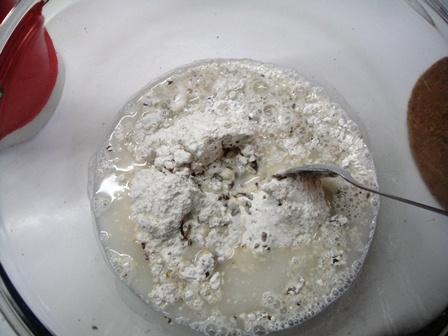
This recipe is just like the straight dough recipes as all the ingredients are added in one go and mixed. Simple and easy.
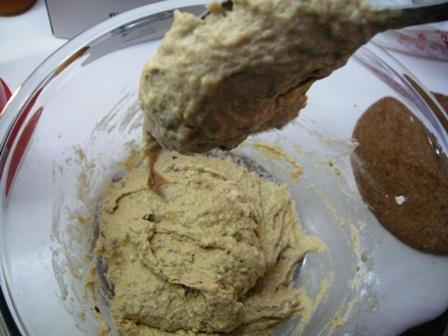
I made sure I gave it a through mix to get all the gluten out.
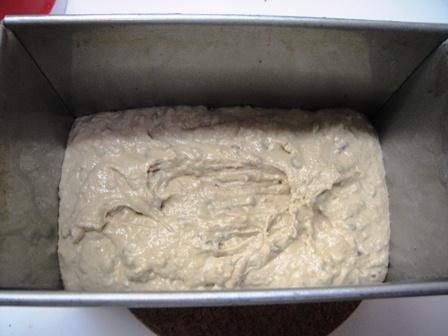
And here it is ready to bake. I think the whole process did not take even 15 minutes. If we get it right, this is a very fast bread making process.
I kept watching it as it baked in the oven at my standard temperature of 210C (410F). I didn’t rise within the first twenty minutes. I suspected something amiss. It could have been that I had used cold water and the baking powder was reacting slowly. But after 45 minutes I knew something was seriously wrong with the recipe. So I checked my baking powder bottle. You those little ubiquitous sterile plastic tumbler like bottles holding every chemical on earth. They all look alike and I reached into my cupboard and picked out what I had used as baking powder and realised I had used Cream of Tartar. No wonder it didn’t rise. After one hour it looked cooked on the outside but when I sliced into it, there was a slightly raw centre.
Moral of the story … check what you are adding into your recipe.
I quickly repeated the recipe but with a little less water. Here is the recipe:-
| Item | Ingredients | Percentage | Weight | Weight |
| (%) | (g) | oz. | ||
| 1 | Bread Flour | 100 | 300 | 10.56 |
| 2 | Sugar | 1 | 3 | 0.11 |
| 3 | Molasses | 5 | 15 | 0.53 |
| 4 | Water, Cold | 90 | 270 | 9.50 |
| 5 | Salt | 2 | 6 | 0.21 |
| 6 | Bran | 0 | 0 | 0.00 |
| 7 | Wheat Germ | 5 | 15 | 0.53 |
| 8 | Flax seeds | 5 | 15 | 0.53 |
| 9 | Sesame seeds | 5 | 15 | 0.53 |
| 10 | Sunflower seeds | 5 | 15 | 0.53 |
| 11 | Virgin Coconut Oil | 3 | 9 | 0.32 |
| 12 | Olive Oil | 3 | 9 | 0.32 |
| 13 | Baking Powder | 5 | 15 | 0.53 |
This did begin to rise within the first 20 minutes of baking. As you can see from the pictures what a difference baking powder does make.
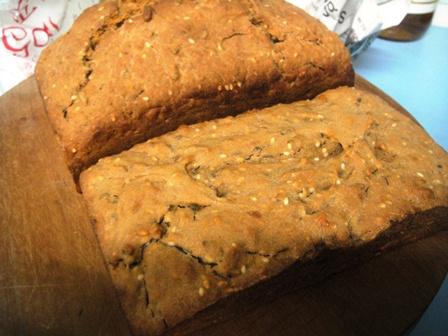
The bread in the foreground is one made with cream of tartar and the bread in the back ground is one made with baking powder.
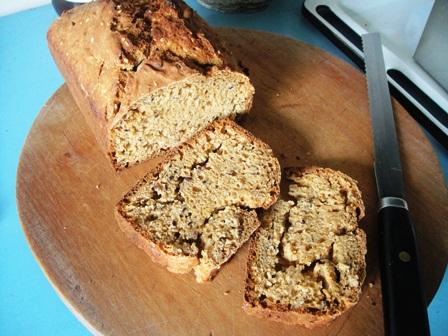
There were a few problems with this bread. Firstly, it was slightly off taste and I think it was because I had used too much baking powder. Secondly, the bread broke up very easily. I would not hold as a slice. Thirdly, as the bread baked it cracked open to release the gases. That would mean that the viscosity of the dough was not good enough, it had to be a little more ‘watery’. And that would mean either more water and or oil to allow it to expand before it sets (bakes) or I should have used a higher temperature to force the gases from the baking powder to be released quickly before the dough set into bread.
There is another thing I forgot to mention. I forgot to add the baking powder. I realised that when I was about to bake the bread. I quickly mixed in the baking powder. It could be that the baking powder was not mixed in properly hence the large gaps or holes in the bread causing it break up easily.
I am close; I will solve this and let you know how to make bread without yeast. Do note this is my ‘standard ingredients’ recipe. You do not have to use virgin coconut oil or olive oil. You can use any oil to lower the viscosity of the dough. These oils are healthy oils and that is why I use them. Furthermore, this is not a true wholemeal bread recipe as I am mixing wholemeal and multi-seed recipes into one bread. Molasses (or treacle) is rich in trace minerals. Why not get all the nutrition you can get into one mouth full.
Leave a Reply